
The Project Gutenberg EBook of Lost Mine Trail, by Anonymous
This eBook is for the use of anyone anywhere in the United States and most
other parts of the world at no cost and with almost no restrictions
whatsoever. You may copy it, give it away or re-use it under the terms of
the Project Gutenberg License included with this eBook or online at
www.gutenberg.org. If you are not located in the United States, you'll have
to check the laws of the country where you are located before using this ebook.
Title: Lost Mine Trail
Big Bend National Park, Texas
Author: Anonymous
Release Date: June 12, 2019 [EBook #59740]
Language: English
Character set encoding: UTF-8
*** START OF THIS PROJECT GUTENBERG EBOOK LOST MINE TRAIL ***
Produced by Stephen Hutcheson, Lisa Corcoran and the Online
Distributed Proofreading Team at http://www.pgdp.net

(The cover photograph of this booklet is furnished through the courtesy of Peter Koch.)
BIG BEND NATIONAL PARK
TEXAS
PRICE 10 CENTS IF YOU TAKE THIS BOOKLET HOME
Of the many romantic legends which abound throughout the West, few match the Lost Mine story from which the peak takes its name. Is it true? Did the mine exist? Or was it a campfire fabrication handed down from generation to generation?
Early Spanish explorers of the Southwest, in their fervent search for gold and other riches, discovered and developed many mines, some yielding silver and gold. According to legend, a rich ore body was discovered on the highest point of Lost Mine Peak. Life-term prisoners were forced to work the mine. These men were blindfolded on several occasions in their march from the Presidio in San Vicente, Mexico, to prevent them from learning its location. The ruins of this presidio may still be observed some 20 miles southwest of this peak across the Rio Grande in Mexico.
A story relates how the fierce Comanche Indians, who resented the Spaniards’ invasion of their homeland and hunting grounds, attacked and killed them to the last man. The last act, so goes the story, was to seal the mine entrance to prevent further exploitation.
Legend states that if a person stands in the chapel door of San Vicente’s Mission on Easter morn, he can watch the sun’s first rays strike Lost Mine Peak at the exact mine entrance.
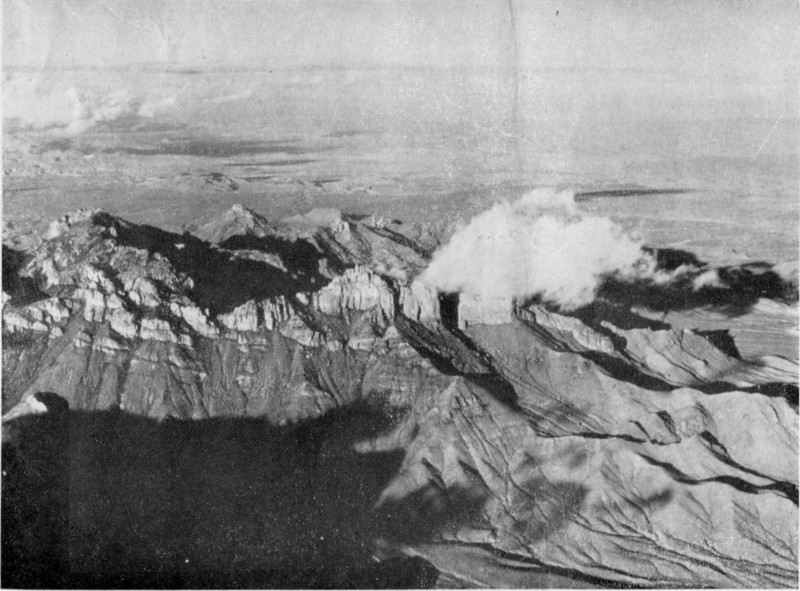
Lost Mine Peak in the Chisos Mountains
(Photo by 111th Photo Sec., Texas Nat’l Guard)
This is your guidebook for using the trail which starts at this registration desk. For about one mile of this walk the interesting plants, unusual geological features and other things of interest are explained. Each object of special interest is marked by a numbered stake. Refer to the corresponding number in this booklet, and you will find the name of the plant or feature and a description. The information recorded here is necessarily brief, but the rangers will be glad to answer your questions and give additional information.
1. Evergreen Sumac (Rhus virens). This sumac is commonly found in Green Gulch and through the Chisos Mountains. It bears attractive clusters of small white flowers followed by red berries which are seen in the late autumn and winter.
2. Alligator Juniper (Juniperus deppeana). Observe alligator skin-like bark of the tree which easily identifies this evergreen and gives it its name. Under favorable conditions the species attains an age in excess of 500 years.
3. Mexican Pinyon (Pinus cembroides), is the only species of pine found along this trail. Pinyon is the name given by the early Spanish explorers and was described by Cabeza de Vaca in 1536. The seeds are used by Indians for food and in recent years the nuts of a close relative, Pinus edulis, have become an article of commerce.
4. Gray Oak (Quercus grisea). There are several species of oak on this trail, but this particular one is easily recognized by the blue-gray color of its leaves.
5. Emory Oak (Quercus emoryi). Of the several oaks in the park, this represents one of the larger evergreen groups. The acorns are edible, 2 sweet, and are important as food for birds and small mammals. Notice the glossy hollylike leaves.
6. Graves Oak (Quercus gravesi). Here is another of the oaks with typical notched or toothed leaf margins. The lovely fall colors of the Chisos Mountains (pronounced CHEE-sose) are principally due to the abundance of these trees whose leaves takes on the rusts and reds of autumn.
7. Picture! From this point on the trail there is an excellent view of Green Gulch. The high point on the left (north) of the gulch is Pulliam Peak, 6,921 feet high. The faraway hills are the Rosillos Mountains, so named because of their roan coloring.
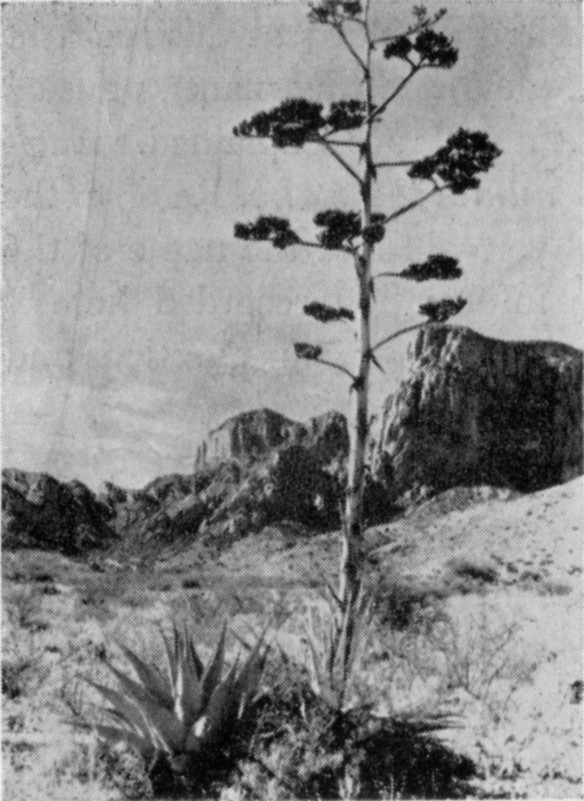
Agave
8. Agave (Agave scabra). There are many different species of agaves (often called century plants) in the Southwest, several occurring in Big Bend. Plants of this group furnish many important products in Mexico, and were utilized by Indians in various ways. Among the products are fiber, food, drink (mescal), soap and medicine. Agaves are grown commercially in more than 40 countries. These plants store up food in the root and leaf systems for many years, finally send up one fast-growing flower stalk, mature their seeds, and then die. The bloom stalk grows almost 10 inches a day and represents the largest bloom of any North American plant.
9. Texas Madrone (Arbutus texana). This beautiful tree has thin, peeling bark. Its red berries, which mature in November, are highly favored by deer which often rise up on their hind legs to reach them. The name “Naked Indian” is sometimes applied because the twigs and branches are the copper color of the Indian torso. A close relative of this madrone is found along the west coast. Most of the madrones along this trail were killed by drouth. This one is sprouting from the old base. There are a number of fine living madrones along the road in upper Green Gulch.
A fine angle view of Casa Grande is obtainable here. This large single mass of volcanic rock (rhyolite) is 7,300 feet high.
10. Skunkbush Sumac, or Squawbush (Rhus trilobata). Although this sumac belongs to the same family as the obnoxious poison ivy, it 3 has none of the latter’s irritating qualities. Leaves turn brilliant shades of red and orange in the autumn.
11. Basketgrass (Nolina erumpens). Although referred to as a grass, this plant belong to the lily family. The narrow, fibrous grasslike leaves often attain a length of 5 feet, making them excellent material for native basketry. The compact clusters of small pinkish-white flowers rarely rise above the rank mass of foliage.
12. Geological Explanation. This rock is called conglomerate, because it is formed from many kinds of rocks from many places. Note the rounded shapes of the individual stones, caused by wearing away of the sharp corners and edges when they were being transported by streams millions of years ago. Later these materials were deposited in beds and under the terrific pressure of overlying masses of sediments were compacted with mineral cementing materials to form the solid mass which you see here.
13. Drooping Juniper (Juniperus flaccida). Appearing to be slightly wilted, the drooping aspects of this graceful evergreen suggests grief. Botanists claim that Big Bend National Park is the only area in the United States in which it is found.
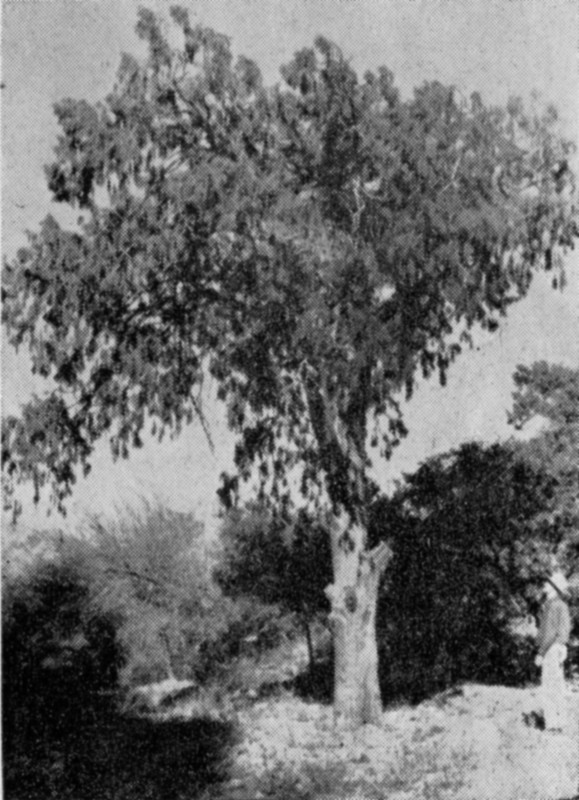
Drooping Juniper
14. Lechuguilla (Agave lechuguilla) (pronounced lay-choo-GHEE-yuh) is a small species of agave whose leaf crown somewhat resembles a bunch of green bananas, and does not belong to the cactus family. The plant is so well protected by its spine-tipped leaves that even hungry goats refrain from eating it. The fibers within the fleshy leaves are used extensively in northern Mexico for making brushes, matting, coarse twine and rope. The short stem is used as a substitute for soap.
15. Claretcup Echinocereus (Echinocereus triglochidiatus). This is one of the commonest and most spectacular of our hedgehog cactuses. Occasionally, plants will have as many as 50 salmon-colored blossoms open at the same time.
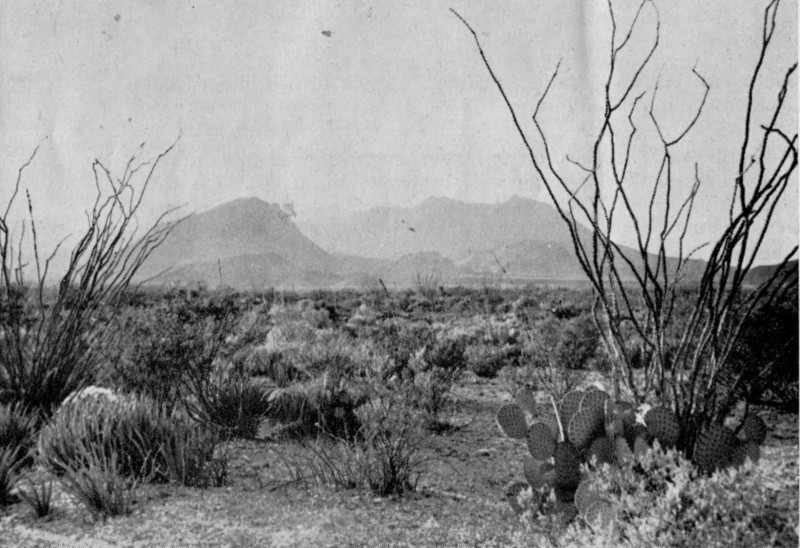
Desert vegetation and Chisos Mountains as seen from the east.
16. Engelmann Pricklypear (Opuntia engelmanni) is one of the desert’s most useful plants. Its fruits may be eaten raw and delicious jams and jellies may be made from them. When young and tender, the young joints are called “nopalitas” (no-pahl-EE-tahs), and are cooked and eaten. Ranchmen burn off the spines to supply hungry cattle with food when the range is poor. In the lower elevations of the park a lovely purple-colored species is found, known as purple-tinge cactus.
17. Strawberry Cactus (Echinocereus stramineus) has one of the desert’s tastiest fruits. When ripe, the fruit resembles a strawberry in texture and is delicious served with cream. The blossom is a deep red and is one of the park’s gems of floral beauty. Large numbers of these dome-shaped plant mounds may be observed along the highways throughout the park.
18. Brownpitaya (Echinocereus chloranthus) is one of the so-called rainbow cactus group. Notice the banded color separation of the short needles. The small brown flowers grow around the plant in large numbers during the bloom period. Another variety, which grows at low elevations in the park, has yellow-orange blossoms reaching a diameter of 4 inches.
19. Mountain-Mahogany (Cercocarpus eximius). The wood is extremely hard, so brittle that it may be broken very easily. Deer browse on the leaves, and, outside the park, cattle and sheep feed upon it.
20. Lichen. Raise your eyes to the exposed barren escarpments of Casa Grande and other rock outcroppings. Here you observe greens, blacks, and other colors. Much of this color may be attributed to the lichens (LYK-ehnz) encrusting the bare rock surfaces.
The small colorful organisms are the first visible signs of life to gain a foothold on rocks. Without true roots, this little “mutual” obtains moisture from the atmosphere. A lichen is actually a fungus and an alga living together in mutual dependence (one provides board and the other room for both). As a product of their life processes, carbonic acid is formed. This slowly disintegrates the rock, helping to form soil, thus aiding in the production of suitable living conditions for higher types of plants.
21. Ash (Fraxinus sp.). Ash has long been identified as a very useful wood; even the early Indians utilized it for paddles, bows, arrows, etc. The winged seed resembles a small canoe paddle.
22. One-Seed Juniper (Juniperus monosperma). There are four junipers found in the park. (You have already seen two of the others along this trail.) This one is so named because it has but one seed in each berry. Junipers (often miscalled cedars) are distinguished from other cone-bearers by the seeds being enclosed in a berry instead of a cone. The wood is resistant to decay and used much for posts. Of course, in a National Park, trees are preserved for their scenic and watershed protection value and are not harvested for commercial purposes.
23. Another picture just ahead—Striking view of Juniper Canyon.
Help Protect the Park from FIRE
Please Smoke Only in Designated Areas
As an inducement for hikers desiring to continue farther along this trail, an orientation table has been constructed about 1½ miles beyond this point. The table points out the major landscape features together with their elevations. From the same general area, a spectacular view of the rugged Big Bend country may be enjoyed.
Millions of years ago, the ocean which extended from the Gulf of Mexico to the Arctic Circle covered this part of west Texas. Muds, sands, and gravels were deposited in the bottom of that ocean. In these sands and gravels were preserved the remains of fish, shellfish, and various other forms of sea life.
Tremendous pressures within the globe’s interior caused the earth’s surface to rise in this region and the waters to recede. Much of the area became swampy, forming suitable habitat for the giant dinosaurs. Peat beds were compressed to form coal deposits. The remains of these coal beds as well as of petrified trees and dinosaur bones may be seen in the rock exposed in various parts of the park. At a still later date there were 6 more extensive earth movements which caused great breaks to occur in the earth’s surface.
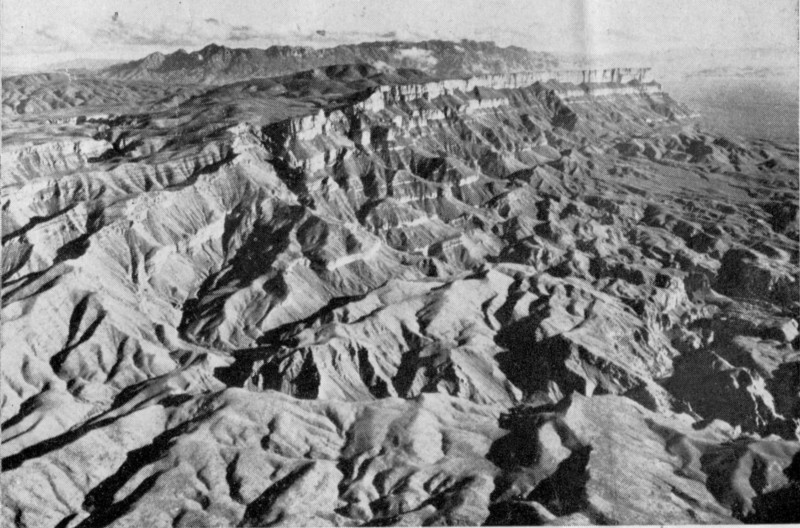
Sierra del Carmen in Mexico
Generally speaking, the geologic structure in the Big Bend area is a “sunken block” that might be compared to cutting through the elevated landscape twice. One cut is along the Sierra del Carmen mountains on the east, and the other at Santa Elena Canyon on the west. The area between the two cuts has sunk an average of several thousand feet. The central part of this block has been arched upward forming the Mariscal, Chisos, and Christmas Mountains.
Part of this uplift was caused by volcanic activity. Large masses of molten rock pushed toward the earth’s surface and arched and deformed the overlying sedimentary layers that had long before been deposited on the floor of the ocean. The Chisos Mountains were formed by this volcanic pressure.
As you look south or north, you see an extensive plain that is underlain very largely by sedimentary rock layers. The isolated peaks for the most part were caused by hot lava that pushed up from below, then cooled to make the present highlands. This is also true of the Chisos Mountains which are a much larger mass. Cooling of these melted rocks caused fracture joints, or shrinkage cracks, and weathering along these breaks caused the columns, spires, buttresses, and pinnacles that you see in all directions near you. Forces of erosion have done most of the carving, forming the various rugged features near at hand.
The geological history is very complex and cannot be even summarized in a few paragraphs. Park Rangers can give you additional information regarding the geological history, or explain the origin of features you may wish to know more about.
| Approximate Round Trip Time | ||||
|---|---|---|---|---|
| 1. | HIKING TRIPS | |||
| A. | Lost Mine Trail | 3 hours | ||
| B. | Juniper Flats | 2 hours | ||
| C. | Window Trail | 3½ hours | ||
| D. | South Rim Loop Trail | 10 hours | ||
| 2. | HORSEBACK TRAIL TRIPS | |||
| A. | Juniper Flats | 2 hours | ||
| B. | Window Trail | 3½ hours | ||
| C. | South Rim Loop Trail | 9 hours | ||
| D. | Pack Trips by special arrangement. | |||
| 3. | AUTO TRIPS | |||
| A. | Santa Elena Canyon | 4-6 hours | ||
| 1. | Visit Mouth of Canyon. | |||
| 2. | Castolon trading post. | |||
| 3. | Terlingua and Study Butte ghost mining towns (outside park) | |||
| B. | Boquillas Canyon | 4-6 hours | ||
| 1. | Excellent View of Del Carmen Mountains and Mexican Village of Boquillas. | |||
| 4. | SUNSETS | |||
| A. | From the Basin through the “Window.” | |||
| B. | Del Carmen from Vicinity of Lower Tornillo and Boquillas. | |||
| C. | Chisos Mountains from vicinity of Lower Tornillo and Boquillas. | |||
| D. | Chisos Mountains from vicinity of Santa Elena Canyon and Study Butte Area. | |||
| 5. | SUNRISE | |||
| A. | Over Casa Grande from the Basin. | |||
| B. | Over the Del Carmen from vicinity of Hot Springs and Boquillas. | |||
| C. | Over the Chisos Mountains from Santa Elena area. | |||
| 6. | WILDLIFE | |||
| A. | Over 55 mammals have been identified to date. | |||
| B. | Approximately 200 birds have been identified to date, including the rare Colima warbler and Aplomado falcon. | |||
| Fifty-four reptiles, which include 4 species of turtles, 22 species of lizards, and 28 species of snakes. | ||||
| 7. | WILDFLOWERS, TREES, AND SHRUBS (1,100 plants identified to date) | |||
| A. | Cactuses and other desert flowers are usually at their height of bloom from the latter part of March to the middle of April. | |||
| B. | Semi-desert shrubs—mostly July, August, and early September, depending upon rain. | |||
| C. | Autumn foliage coloring—late November and first half of December. | |||
| 8. | GEOLOGY | |||
| A. | The oldest rocks (Persimmon Gap) are comparable in age and structure to those found in the Appalachian Mountains. | |||
| B. | The Lowland area is underlain by rock with fossil content, comparable to the Gulf Coast and Great Plains areas. | |||
| C. | Chisos Mountain volcanic area is comparable in age and structure to the great volcanic activity period of the Northwest. | |||
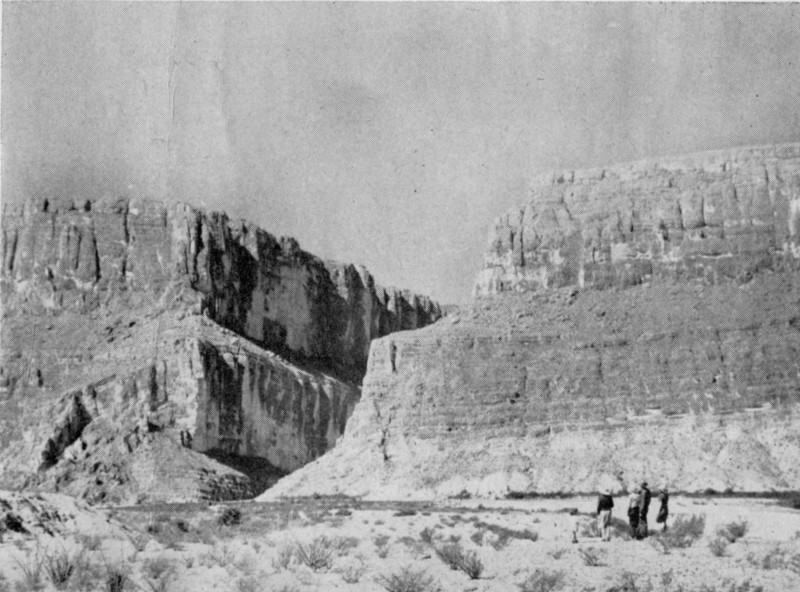
Santa Elena Canyon
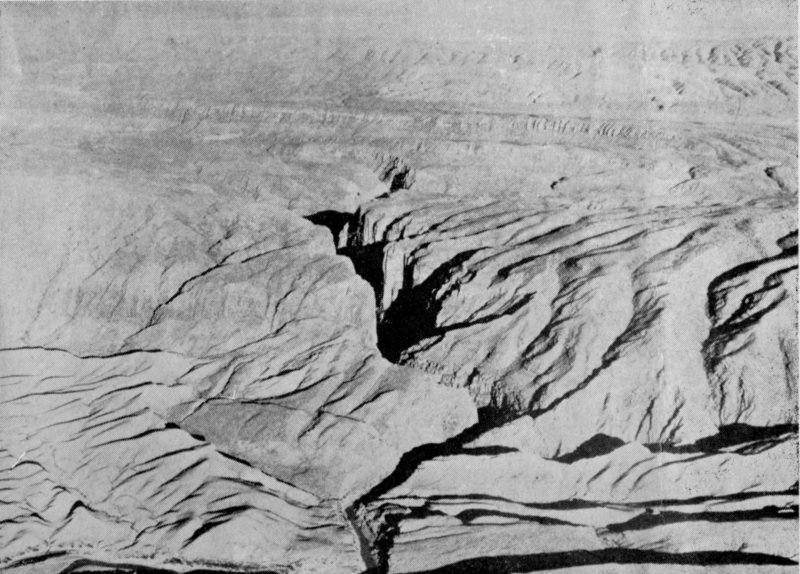
Mariscal Canyon
(Photo by 111th Photo Sec., Texas Nat’l Guard)
Big Bend is one of the newest of the great, scenic National Parks, having been established June 12, 1944. A unit of the National Park System, it is administered by the National Park Service, U. S. Department of the Interior.
MISSION 66 is a 10 year development program, now in progress, to enable the National Park Service to help you enjoy and understand the Parks and Monuments, and at the same time, preserve their scenic and scientific values for your children and for future generations.
If you are interested in the work of the National Park Service and in the cause of conservation in general, you can give active expression of this interest, and lend support by alining yourself with one of the numerous conservation organizations which act as spokesmen for those who wish our scenic heritage to be kept unimpaired for the enjoyment of future generations.
This booklet is published in cooperation with the
National Park Service by the
SOUTHWESTERN MONUMENTS ASSOCIATION
Box 1562-P, Gila Pueblo, Globe, Arizona
which is a non-profit distributing organization pledged to aid in the preservation and interpretation of southwestern features of outstanding national interest.
The Association lists for sale many interesting and authentic publications for adults and children, and color slides on Southwestern subjects. These make fine gifts for birthdays, parties, and special occasions, and many prove to be of value to children in their school work and hobbies.
For the complete sales list of more than 100 publications and 1700 color slides on Southwestern Indians, geology, ruins, plants, animals, history, etc., you can obtain one by mail by writing to the above address.
* * * * * * * *
ALSO AVAILABLE
are the following booklets of information on Big Bend National Park:
The following may also be purchased in the park:
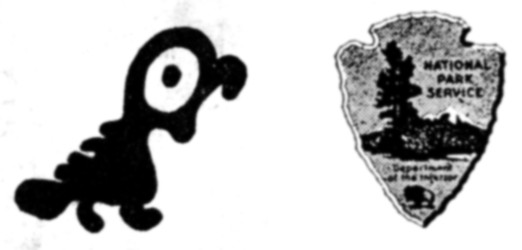
SOUTHWESTERN MONUMENTS ASSOCIATION
Box 1562-P—Gila Pueblo, Globe, Arizona
End of the Project Gutenberg EBook of Lost Mine Trail, by Anonymous
*** END OF THIS PROJECT GUTENBERG EBOOK LOST MINE TRAIL ***
***** This file should be named 59740-h.htm or 59740-h.zip *****
This and all associated files of various formats will be found in:
http://www.gutenberg.org/5/9/7/4/59740/
Produced by Stephen Hutcheson, Lisa Corcoran and the Online
Distributed Proofreading Team at http://www.pgdp.net
Updated editions will replace the previous one--the old editions will
be renamed.
Creating the works from print editions not protected by U.S. copyright
law means that no one owns a United States copyright in these works,
so the Foundation (and you!) can copy and distribute it in the United
States without permission and without paying copyright
royalties. Special rules, set forth in the General Terms of Use part
of this license, apply to copying and distributing Project
Gutenberg-tm electronic works to protect the PROJECT GUTENBERG-tm
concept and trademark. Project Gutenberg is a registered trademark,
and may not be used if you charge for the eBooks, unless you receive
specific permission. If you do not charge anything for copies of this
eBook, complying with the rules is very easy. You may use this eBook
for nearly any purpose such as creation of derivative works, reports,
performances and research. They may be modified and printed and given
away--you may do practically ANYTHING in the United States with eBooks
not protected by U.S. copyright law. Redistribution is subject to the
trademark license, especially commercial redistribution.
START: FULL LICENSE
THE FULL PROJECT GUTENBERG LICENSE
PLEASE READ THIS BEFORE YOU DISTRIBUTE OR USE THIS WORK
To protect the Project Gutenberg-tm mission of promoting the free
distribution of electronic works, by using or distributing this work
(or any other work associated in any way with the phrase "Project
Gutenberg"), you agree to comply with all the terms of the Full
Project Gutenberg-tm License available with this file or online at
www.gutenberg.org/license.
Section 1. General Terms of Use and Redistributing Project
Gutenberg-tm electronic works
1.A. By reading or using any part of this Project Gutenberg-tm
electronic work, you indicate that you have read, understand, agree to
and accept all the terms of this license and intellectual property
(trademark/copyright) agreement. If you do not agree to abide by all
the terms of this agreement, you must cease using and return or
destroy all copies of Project Gutenberg-tm electronic works in your
possession. If you paid a fee for obtaining a copy of or access to a
Project Gutenberg-tm electronic work and you do not agree to be bound
by the terms of this agreement, you may obtain a refund from the
person or entity to whom you paid the fee as set forth in paragraph
1.E.8.
1.B. "Project Gutenberg" is a registered trademark. It may only be
used on or associated in any way with an electronic work by people who
agree to be bound by the terms of this agreement. There are a few
things that you can do with most Project Gutenberg-tm electronic works
even without complying with the full terms of this agreement. See
paragraph 1.C below. There are a lot of things you can do with Project
Gutenberg-tm electronic works if you follow the terms of this
agreement and help preserve free future access to Project Gutenberg-tm
electronic works. See paragraph 1.E below.
1.C. The Project Gutenberg Literary Archive Foundation ("the
Foundation" or PGLAF), owns a compilation copyright in the collection
of Project Gutenberg-tm electronic works. Nearly all the individual
works in the collection are in the public domain in the United
States. If an individual work is unprotected by copyright law in the
United States and you are located in the United States, we do not
claim a right to prevent you from copying, distributing, performing,
displaying or creating derivative works based on the work as long as
all references to Project Gutenberg are removed. Of course, we hope
that you will support the Project Gutenberg-tm mission of promoting
free access to electronic works by freely sharing Project Gutenberg-tm
works in compliance with the terms of this agreement for keeping the
Project Gutenberg-tm name associated with the work. You can easily
comply with the terms of this agreement by keeping this work in the
same format with its attached full Project Gutenberg-tm License when
you share it without charge with others.
1.D. The copyright laws of the place where you are located also govern
what you can do with this work. Copyright laws in most countries are
in a constant state of change. If you are outside the United States,
check the laws of your country in addition to the terms of this
agreement before downloading, copying, displaying, performing,
distributing or creating derivative works based on this work or any
other Project Gutenberg-tm work. The Foundation makes no
representations concerning the copyright status of any work in any
country outside the United States.
1.E. Unless you have removed all references to Project Gutenberg:
1.E.1. The following sentence, with active links to, or other
immediate access to, the full Project Gutenberg-tm License must appear
prominently whenever any copy of a Project Gutenberg-tm work (any work
on which the phrase "Project Gutenberg" appears, or with which the
phrase "Project Gutenberg" is associated) is accessed, displayed,
performed, viewed, copied or distributed:
This eBook is for the use of anyone anywhere in the United States and
most other parts of the world at no cost and with almost no
restrictions whatsoever. You may copy it, give it away or re-use it
under the terms of the Project Gutenberg License included with this
eBook or online at www.gutenberg.org. If you are not located in the
United States, you'll have to check the laws of the country where you
are located before using this ebook.
1.E.2. If an individual Project Gutenberg-tm electronic work is
derived from texts not protected by U.S. copyright law (does not
contain a notice indicating that it is posted with permission of the
copyright holder), the work can be copied and distributed to anyone in
the United States without paying any fees or charges. If you are
redistributing or providing access to a work with the phrase "Project
Gutenberg" associated with or appearing on the work, you must comply
either with the requirements of paragraphs 1.E.1 through 1.E.7 or
obtain permission for the use of the work and the Project Gutenberg-tm
trademark as set forth in paragraphs 1.E.8 or 1.E.9.
1.E.3. If an individual Project Gutenberg-tm electronic work is posted
with the permission of the copyright holder, your use and distribution
must comply with both paragraphs 1.E.1 through 1.E.7 and any
additional terms imposed by the copyright holder. Additional terms
will be linked to the Project Gutenberg-tm License for all works
posted with the permission of the copyright holder found at the
beginning of this work.
1.E.4. Do not unlink or detach or remove the full Project Gutenberg-tm
License terms from this work, or any files containing a part of this
work or any other work associated with Project Gutenberg-tm.
1.E.5. Do not copy, display, perform, distribute or redistribute this
electronic work, or any part of this electronic work, without
prominently displaying the sentence set forth in paragraph 1.E.1 with
active links or immediate access to the full terms of the Project
Gutenberg-tm License.
1.E.6. You may convert to and distribute this work in any binary,
compressed, marked up, nonproprietary or proprietary form, including
any word processing or hypertext form. However, if you provide access
to or distribute copies of a Project Gutenberg-tm work in a format
other than "Plain Vanilla ASCII" or other format used in the official
version posted on the official Project Gutenberg-tm web site
(www.gutenberg.org), you must, at no additional cost, fee or expense
to the user, provide a copy, a means of exporting a copy, or a means
of obtaining a copy upon request, of the work in its original "Plain
Vanilla ASCII" or other form. Any alternate format must include the
full Project Gutenberg-tm License as specified in paragraph 1.E.1.
1.E.7. Do not charge a fee for access to, viewing, displaying,
performing, copying or distributing any Project Gutenberg-tm works
unless you comply with paragraph 1.E.8 or 1.E.9.
1.E.8. You may charge a reasonable fee for copies of or providing
access to or distributing Project Gutenberg-tm electronic works
provided that
* You pay a royalty fee of 20% of the gross profits you derive from
the use of Project Gutenberg-tm works calculated using the method
you already use to calculate your applicable taxes. The fee is owed
to the owner of the Project Gutenberg-tm trademark, but he has
agreed to donate royalties under this paragraph to the Project
Gutenberg Literary Archive Foundation. Royalty payments must be paid
within 60 days following each date on which you prepare (or are
legally required to prepare) your periodic tax returns. Royalty
payments should be clearly marked as such and sent to the Project
Gutenberg Literary Archive Foundation at the address specified in
Section 4, "Information about donations to the Project Gutenberg
Literary Archive Foundation."
* You provide a full refund of any money paid by a user who notifies
you in writing (or by e-mail) within 30 days of receipt that s/he
does not agree to the terms of the full Project Gutenberg-tm
License. You must require such a user to return or destroy all
copies of the works possessed in a physical medium and discontinue
all use of and all access to other copies of Project Gutenberg-tm
works.
* You provide, in accordance with paragraph 1.F.3, a full refund of
any money paid for a work or a replacement copy, if a defect in the
electronic work is discovered and reported to you within 90 days of
receipt of the work.
* You comply with all other terms of this agreement for free
distribution of Project Gutenberg-tm works.
1.E.9. If you wish to charge a fee or distribute a Project
Gutenberg-tm electronic work or group of works on different terms than
are set forth in this agreement, you must obtain permission in writing
from both the Project Gutenberg Literary Archive Foundation and The
Project Gutenberg Trademark LLC, the owner of the Project Gutenberg-tm
trademark. Contact the Foundation as set forth in Section 3 below.
1.F.
1.F.1. Project Gutenberg volunteers and employees expend considerable
effort to identify, do copyright research on, transcribe and proofread
works not protected by U.S. copyright law in creating the Project
Gutenberg-tm collection. Despite these efforts, Project Gutenberg-tm
electronic works, and the medium on which they may be stored, may
contain "Defects," such as, but not limited to, incomplete, inaccurate
or corrupt data, transcription errors, a copyright or other
intellectual property infringement, a defective or damaged disk or
other medium, a computer virus, or computer codes that damage or
cannot be read by your equipment.
1.F.2. LIMITED WARRANTY, DISCLAIMER OF DAMAGES - Except for the "Right
of Replacement or Refund" described in paragraph 1.F.3, the Project
Gutenberg Literary Archive Foundation, the owner of the Project
Gutenberg-tm trademark, and any other party distributing a Project
Gutenberg-tm electronic work under this agreement, disclaim all
liability to you for damages, costs and expenses, including legal
fees. YOU AGREE THAT YOU HAVE NO REMEDIES FOR NEGLIGENCE, STRICT
LIABILITY, BREACH OF WARRANTY OR BREACH OF CONTRACT EXCEPT THOSE
PROVIDED IN PARAGRAPH 1.F.3. YOU AGREE THAT THE FOUNDATION, THE
TRADEMARK OWNER, AND ANY DISTRIBUTOR UNDER THIS AGREEMENT WILL NOT BE
LIABLE TO YOU FOR ACTUAL, DIRECT, INDIRECT, CONSEQUENTIAL, PUNITIVE OR
INCIDENTAL DAMAGES EVEN IF YOU GIVE NOTICE OF THE POSSIBILITY OF SUCH
DAMAGE.
1.F.3. LIMITED RIGHT OF REPLACEMENT OR REFUND - If you discover a
defect in this electronic work within 90 days of receiving it, you can
receive a refund of the money (if any) you paid for it by sending a
written explanation to the person you received the work from. If you
received the work on a physical medium, you must return the medium
with your written explanation. The person or entity that provided you
with the defective work may elect to provide a replacement copy in
lieu of a refund. If you received the work electronically, the person
or entity providing it to you may choose to give you a second
opportunity to receive the work electronically in lieu of a refund. If
the second copy is also defective, you may demand a refund in writing
without further opportunities to fix the problem.
1.F.4. Except for the limited right of replacement or refund set forth
in paragraph 1.F.3, this work is provided to you 'AS-IS', WITH NO
OTHER WARRANTIES OF ANY KIND, EXPRESS OR IMPLIED, INCLUDING BUT NOT
LIMITED TO WARRANTIES OF MERCHANTABILITY OR FITNESS FOR ANY PURPOSE.
1.F.5. Some states do not allow disclaimers of certain implied
warranties or the exclusion or limitation of certain types of
damages. If any disclaimer or limitation set forth in this agreement
violates the law of the state applicable to this agreement, the
agreement shall be interpreted to make the maximum disclaimer or
limitation permitted by the applicable state law. The invalidity or
unenforceability of any provision of this agreement shall not void the
remaining provisions.
1.F.6. INDEMNITY - You agree to indemnify and hold the Foundation, the
trademark owner, any agent or employee of the Foundation, anyone
providing copies of Project Gutenberg-tm electronic works in
accordance with this agreement, and any volunteers associated with the
production, promotion and distribution of Project Gutenberg-tm
electronic works, harmless from all liability, costs and expenses,
including legal fees, that arise directly or indirectly from any of
the following which you do or cause to occur: (a) distribution of this
or any Project Gutenberg-tm work, (b) alteration, modification, or
additions or deletions to any Project Gutenberg-tm work, and (c) any
Defect you cause.
Section 2. Information about the Mission of Project Gutenberg-tm
Project Gutenberg-tm is synonymous with the free distribution of
electronic works in formats readable by the widest variety of
computers including obsolete, old, middle-aged and new computers. It
exists because of the efforts of hundreds of volunteers and donations
from people in all walks of life.
Volunteers and financial support to provide volunteers with the
assistance they need are critical to reaching Project Gutenberg-tm's
goals and ensuring that the Project Gutenberg-tm collection will
remain freely available for generations to come. In 2001, the Project
Gutenberg Literary Archive Foundation was created to provide a secure
and permanent future for Project Gutenberg-tm and future
generations. To learn more about the Project Gutenberg Literary
Archive Foundation and how your efforts and donations can help, see
Sections 3 and 4 and the Foundation information page at
www.gutenberg.org
Section 3. Information about the Project Gutenberg Literary Archive Foundation
The Project Gutenberg Literary Archive Foundation is a non profit
501(c)(3) educational corporation organized under the laws of the
state of Mississippi and granted tax exempt status by the Internal
Revenue Service. The Foundation's EIN or federal tax identification
number is 64-6221541. Contributions to the Project Gutenberg Literary
Archive Foundation are tax deductible to the full extent permitted by
U.S. federal laws and your state's laws.
The Foundation's principal office is in Fairbanks, Alaska, with the
mailing address: PO Box 750175, Fairbanks, AK 99775, but its
volunteers and employees are scattered throughout numerous
locations. Its business office is located at 809 North 1500 West, Salt
Lake City, UT 84116, (801) 596-1887. Email contact links and up to
date contact information can be found at the Foundation's web site and
official page at www.gutenberg.org/contact
For additional contact information:
Dr. Gregory B. Newby
Chief Executive and Director
gbnewby@pglaf.org
Section 4. Information about Donations to the Project Gutenberg
Literary Archive Foundation
Project Gutenberg-tm depends upon and cannot survive without wide
spread public support and donations to carry out its mission of
increasing the number of public domain and licensed works that can be
freely distributed in machine readable form accessible by the widest
array of equipment including outdated equipment. Many small donations
($1 to $5,000) are particularly important to maintaining tax exempt
status with the IRS.
The Foundation is committed to complying with the laws regulating
charities and charitable donations in all 50 states of the United
States. Compliance requirements are not uniform and it takes a
considerable effort, much paperwork and many fees to meet and keep up
with these requirements. We do not solicit donations in locations
where we have not received written confirmation of compliance. To SEND
DONATIONS or determine the status of compliance for any particular
state visit www.gutenberg.org/donate
While we cannot and do not solicit contributions from states where we
have not met the solicitation requirements, we know of no prohibition
against accepting unsolicited donations from donors in such states who
approach us with offers to donate.
International donations are gratefully accepted, but we cannot make
any statements concerning tax treatment of donations received from
outside the United States. U.S. laws alone swamp our small staff.
Please check the Project Gutenberg Web pages for current donation
methods and addresses. Donations are accepted in a number of other
ways including checks, online payments and credit card donations. To
donate, please visit: www.gutenberg.org/donate
Section 5. General Information About Project Gutenberg-tm electronic works.
Professor Michael S. Hart was the originator of the Project
Gutenberg-tm concept of a library of electronic works that could be
freely shared with anyone. For forty years, he produced and
distributed Project Gutenberg-tm eBooks with only a loose network of
volunteer support.
Project Gutenberg-tm eBooks are often created from several printed
editions, all of which are confirmed as not protected by copyright in
the U.S. unless a copyright notice is included. Thus, we do not
necessarily keep eBooks in compliance with any particular paper
edition.
Most people start at our Web site which has the main PG search
facility: www.gutenberg.org
This Web site includes information about Project Gutenberg-tm,
including how to make donations to the Project Gutenberg Literary
Archive Foundation, how to help produce our new eBooks, and how to
subscribe to our email newsletter to hear about new eBooks.